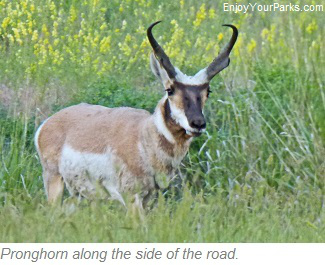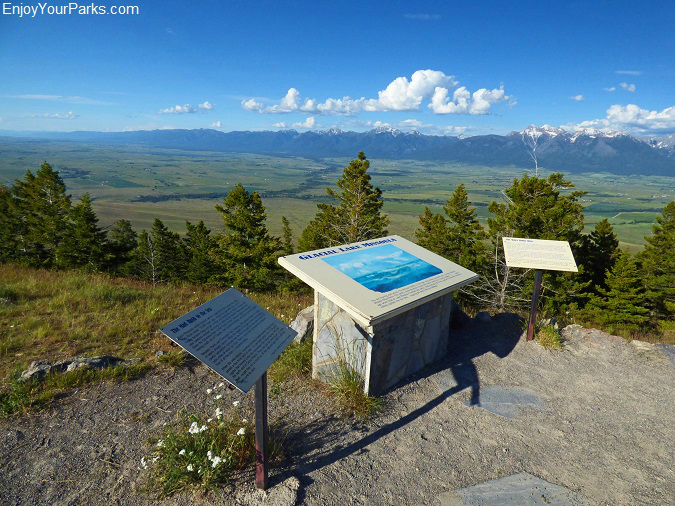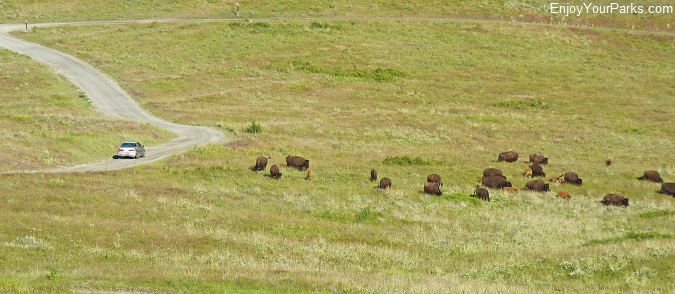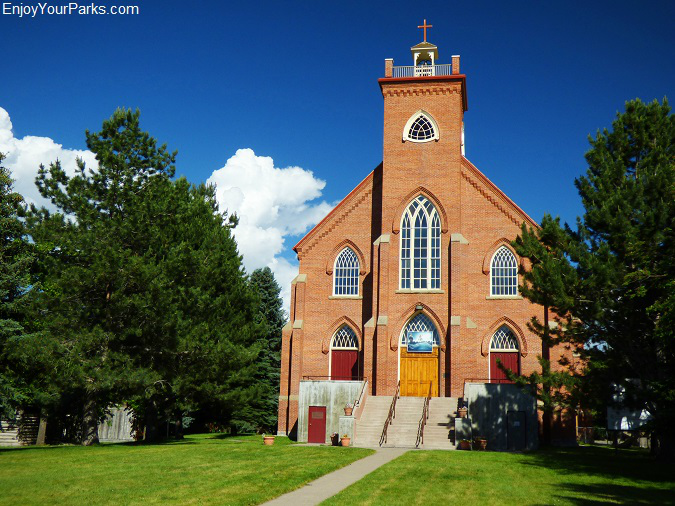National Bison Range
Includes Historic St. Ignatius Mission, U.S. Highway 93 Scenic Drive

National Bison Range, Montana.
National Bison Range
Includes Historic St. Ignatius Mission, U.S. Highway 93 Scenic Drive
"...for a permanent national bison range for the herd of bison..."
- President Theodore Roosevelt, 1908
 The National Bison Range in western Montana is one of the oldest wildlife refuges in the United States. Established in 1908 by President Theodore Roosevelt, the National Bison Range's goal was to maintain a representative herd of bison (American buffalo), in their natural environment, to ensure the preservation of the species and for public enjoyment. The National Bison Range of Montana is also one of the last intact publicly owned intermountain native grassland area in America.
The National Bison Range in western Montana is one of the oldest wildlife refuges in the United States. Established in 1908 by President Theodore Roosevelt, the National Bison Range's goal was to maintain a representative herd of bison (American buffalo), in their natural environment, to ensure the preservation of the species and for public enjoyment. The National Bison Range of Montana is also one of the last intact publicly owned intermountain native grassland area in America.
Diminished Range
30 to 60 million bison roamed North America for thousands of years, but they reached an all time low of only 100 in the late 1800's. Since 1908, the National Bison Range has been an important entity in successfully bringing back these iconic American animals. It is felt by many that this recovery was one of the most remarkable accomplishments in the history of the National Wildlife Refuge System. Today, not only is the National Bison Range an extremely popular attraction for Montana visitors, but is also serves as the top bison research center in the United States.

National Bison Range, Montana.
Bison or Buffalo?
Both "bison" and "buffalo" are socially acceptable terms for the bison. "Buffalo" is used mainly informally, whereas "bison" is usually used for scientific purposes, such as research papers and lectures. So if you call them "bison" or "buffalo", you're correct either way.

You can call this magnificent animal a Bison or a Buffalo....both names are acceptable.
About The Refuge
 Managed by the U.S. Fish & Wildlife Service, the National Bison Range of Montana is home to National Bison Range Visitor Centerapproximately 500 bison. This 18,800 acre refuge is located about 1 hour north of Missoula off U.S. Highway 93.
Managed by the U.S. Fish & Wildlife Service, the National Bison Range of Montana is home to National Bison Range Visitor Centerapproximately 500 bison. This 18,800 acre refuge is located about 1 hour north of Missoula off U.S. Highway 93.
There is a Visitor Center as well as two scenic gravel roads that allow visitors to drive through the National Bison Range and enjoy the wildlife as well as the spectacular scenery.
The entrance to the refuge is located just off U.S. Highway 93 at Moiese, Montana. There are very clearly marked signs that will direct you to this entrance.
Hiking Trails
In addition to the roadways that take you on a loop through the refuge, there are also several outstanding trails for hikers to enjoy throughout the National Bison Refuge. The trailheads are clearly marked along the gravel roadways.
National Bison Range Complex
The "National Bison Range Complex" includes not only the National Bison Range, but also the Lost Trail, Pablo, Swan River and Ninepipe National Wildlife Refuges. These refuges are located throughout the surrounding area.
Amazing Scenery, Fascinating Wildlife

The view of the Mission Mountain Range from the National Bison Range.
 As you drive the gravel road that takes you through the heart of the refuge, you will not only see wildlife, but you will also enjoy the incredible beauty of the landscape. The National Bison Range is located on large, rolling native grassland hills. Once you get to the top of the hills, you will get a breathtaking view of the famous Flathead Valley and the legendary Mission Mountain Range. to the east.
As you drive the gravel road that takes you through the heart of the refuge, you will not only see wildlife, but you will also enjoy the incredible beauty of the landscape. The National Bison Range is located on large, rolling native grassland hills. Once you get to the top of the hills, you will get a breathtaking view of the famous Flathead Valley and the legendary Mission Mountain Range. to the east.
This drive is so pleasant and scenic, we've always felt that it's worth the time even if you don't see any wildlife! But of course you will see wildlife, and in addition to bison, you have a high probability of seeing mule deer, white tailed deer, pronghorns, coyotes and over 200 species of birds.
There are also bighorn sheep and elk found on the refuge, and if you're really lucky, you might even get a glimpse of a bear, mountain lion or bobcat! The National Bison Range is home to quite a diverse ecosystem of native grasslands, ponderosa pine forests, Douglas fur forests, ponds and riparian areas, which provides a wonderful home to the animals on this amazing refuge.



The scenery throughout the National Bison Range is spectacular!
The elevation of the refuge ranges from 2,585 feet at the front entrance and headquarters, to 4,885 feet above sea level at a spot called "High Point", which sits on Red Sleep Mountain. This location is the highest point on the Range.

There are interesting displays throughout the National Bison Range in Montana.....as well as great views!!!

The view alone is worth the time to drive through the National Bison Range in Montana!
Interesting Geology: Lake Missoula
 Most of the National Bison Range was once under water due to the gigantic prehistoric glacial lake known as "Lake Missoula". This lake was formed about 17,000 years ago by a large ice dam that blocked the flow of the Clark Fork River. Lake Missoula reached an elevation of 4,200 feet above sea level, therefore the high country section of the refuge remained above water. You can still see evidence of ancient beach lines that were formed along the lake shore, especially on the north-facing slopes.
Most of the National Bison Range was once under water due to the gigantic prehistoric glacial lake known as "Lake Missoula". This lake was formed about 17,000 years ago by a large ice dam that blocked the flow of the Clark Fork River. Lake Missoula reached an elevation of 4,200 feet above sea level, therefore the high country section of the refuge remained above water. You can still see evidence of ancient beach lines that were formed along the lake shore, especially on the north-facing slopes.
Native American Heritage
Humans and bison have shared the landscape for thousands of years. Flint spears dated to be 1,200 years old have been found near ancient bison bones, which is an indication of this long age-old relationship between man and buffalo. Native Americans hunted buffalo (bison) for food, shelter and clothing. Many stories passed down through the Plains Indians' culture involve the bison, and this magnificent animal is also an important part of their spirituality and religions.

Visitors enjoying a buffalo herd at the National Bison Range in Montana.

The National Bison Range has a variety of animals in addition to bison, such as this pronghorn.
Beyond The Bison Range....Historic St. Ignatius Mission
Just west of the National Bison Range, along U.S. Highway 93 is the scenic Flathead Valley and the Historic St. Ignatius Mission.
U.S. Highway 93 Scenic Drive
 U.S. Highway 93 is the main highway to Flathead Lake and Glacier National Park, so more than likely you'll be on this road after visiting the National Bison Range anyway. And by the way, U.S. Highway 93 is extremely scenic the moment you begin your journey on it near Missoula, Montana, all the way to Kalispell, Montana.
U.S. Highway 93 is the main highway to Flathead Lake and Glacier National Park, so more than likely you'll be on this road after visiting the National Bison Range anyway. And by the way, U.S. Highway 93 is extremely scenic the moment you begin your journey on it near Missoula, Montana, all the way to Kalispell, Montana.
The Mission Mountain Range towers over the Flathead Valley to the east, all the way to Flathead Lake, and in the town of St. Ignatius, is the Historic St. Ignatius Mission, which is really a fascinating and gorgeous old mission that is worthwhile visiting.

The town of St. Ignatius below the towering Mission Mountain Range along U.S. Highway 93.
Historic St. Ignatius Mission
 The St. Ignatius Mission was originally founded by Father Pierre-Jean De Smet and Father Adrian Hoecken in 1854.
The St. Ignatius Mission was originally founded by Father Pierre-Jean De Smet and Father Adrian Hoecken in 1854.
Listed on the U.S. National Register of Historic Places, the current Historic St. Ignatius Mission that you see today was built on this site between 1891 and 1893. The bricks are made of clay from the surrounding area, and aside from it's overall beauty of Gothic Revival Architecture and history, the most remarkable feature of the St. Ignatius Mission's interior are the 58 amazing murals.
These gorgeous murals were painted by an untrained artist by the name of Brother Joseph Carignano, who was one of the cooks at the mission. If you're driving on U.S. Highway 93 near St. Ignatius, we highly recommend that you stop at this amazing old mission.... you'll be glad you did.

Historic St. Ignatius Mission is well worth the time to visit and explore.




